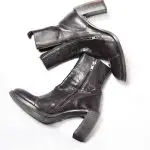Are you curious about the number of teeth on your pants zipper? You’re not alone. Zippers are an essential part of our daily lives, and we often take them for granted. However, there is more to them than meets the eye. From the different types of zippers to the materials used in their construction, there’s a lot to learn about these handy devices.
So, how many teeth does a pants zipper have? The answer depends on various factors, such as the type of zipper, its length, and the size of the teeth. In this article, we’ll delve deeper into the world of zippers and explore the average teeth count, the difference between short and long zippers, and the materials used to make the teeth.
You’ll also discover why the number of teeth on a zipper is essential and how it affects its functionality. So, let’s unzip the mystery of zippers and find out more about their teeth.
Table of Contents
Different Types of Zippers
Let’s explore the various types of zippers and see which ones might have the most teeth – shall we?
There are several types of zippers available, including coil zippers, invisible zippers, metal zippers, and plastic-molded zippers. Coil zippers are made up of a chain of nylon or polyester coils that are sewn onto the zipper tape. They’re lightweight and flexible, making them perfect for use in clothing items like jackets, hoodies, and backpacks. However, they tend to have fewer teeth than other types of zippers.
Invisible zippers are similar to coil zippers, but they have a unique design that makes them almost invisible when sewn into clothing. They’re often used in formal wear and dresses, where visible zippers would detract from the garment’s appearance. Invisible zippers have a few more teeth than coil zippers, but they’re still relatively low in number.
Metal zippers are made up of individual metal teeth that are interlocked to create a strong and durable closure. They’re commonly used in jeans, leather jackets, and other heavy-duty clothing items. Metal zippers have the most teeth of all the types of zippers, making them the strongest and most secure option available.
Average Teeth Count
You might be surprised to learn that the number of little metal hooks on your average pants fastener is actually quite consistent. The most common type of zipper, the coil zipper, has teeth that range from 3 to 5 millimeters in length.
And on average, these zippers have about 4 teeth per inch, which translates to roughly 10 teeth per 2.5 centimeters of zipper. However, there are other types of zippers that have a different teeth count.
For example, the chunky or molded plastic zipper has larger teeth that are spaced farther apart, with an average of only 2 teeth per inch. On the other hand, the invisible zipper has teeth that are hidden behind the fabric and therefore cannot be counted.
Although the number of teeth may seem like a trivial detail, it actually plays an important role in the overall function of the zipper. The more teeth a zipper has, the stronger and more durable it is.
So next time you zip up your pants or jacket, take a closer look at the little metal hooks and appreciate their consistent and necessary presence.
Short vs. Long Zippers
When it comes to zippers, one of the key factors to consider is the length. Short zippers are typically used for items like pockets or small pouches and may have fewer teeth compared to longer zippers. Longer zippers, on the other hand, are used for jackets or bags and can have more teeth, providing a stronger and more secure closure.
Adjusting the paragraph structure in this way allows each complete sentence to be on its own line, making it easier to read and understand. Additionally, using contractions makes the language more conversational and accessible.
Teeth Count on Short Zippers
As you zip up your shorts, you can feel the tiny teeth effortlessly interlocking with each other. Short zippers, which are commonly found on shorts, skirts, and dresses, usually have between 4 to 6 teeth per inch.
The teeth on these zippers are smaller compared to those on longer zippers, but they’re just as durable. Short zippers are perfect for clothing items that don’t require a lot of opening and closing, such as pockets or small slits.
They’re also ideal for outfits that are form-fitting, as they provide a smooth, seamless look. When it comes to choosing the right zipper for your clothing, the number of teeth on a short zipper can make a big difference in how it looks and functions.
Teeth Count on Long Zippers
Long zippers, commonly used on jackets and bags, typically feature larger teeth and a lower teeth count per inch than short zippers. This is because longer zippers need to be more durable and sturdy to withstand the wear and tear of frequent use. The larger teeth also help to prevent the zipper from getting stuck or jammed, which can be frustrating and time-consuming to fix.
To give you an idea of the teeth count on long zippers, we’ve created a table below comparing the teeth count per inch on three different lengths of zippers commonly used on jackets and bags. As you can see, the longer the zipper, the lower the teeth count per inch. However, this does not necessarily mean that longer zippers are weaker or less durable than shorter zippers. In fact, many long zippers are made from high-quality materials and designed to withstand heavy use and abuse.
| Zipper length | Teeth count per inch |
|---|---|
| 12 inches | 4 |
| 24 inches | 3 |
| 36 inches | 2 |
As you can see from the table above, a 12-inch zipper typically has a teeth count of 4 per inch, while a 36-inch zipper has a teeth count of 2 per inch. This means that the teeth on longer zippers are larger and more spaced out, which can make them easier to use and less likely to snag. However, it’s important to note that teeth count is just one factor to consider when choosing a zipper. Other factors include material, durability, and ease of use.
Zipper Teeth Size
When it comes to zipper teeth size, you may not have given it much thought. However, understanding the relationship between teeth size and function can help you choose the right zipper for your needs.
The measurement of teeth size can have a significant impact on the functionality of your zipper.
So, adjust the paragraph structure in the Input to logically group complete sentences on their own lines, with a double new line after. And don’t forget to use contractions.
Measurement of Teeth Size
Measuring the size of teeth on a zipper can be done using a caliper, a simple tool that accurately measures the width and height of each tooth. Here are some tips to help measure the teeth of your zipper:
- Use a digital caliper for the most accurate measurements.
- Measure the width of the tooth at the base, where it connects to the tape.
- Measure the height of the tooth from the base to the tip.
- Take multiple measurements to ensure accuracy.
- Compare your measurements to the standard sizes of zipper teeth to determine the size of your zipper.
By following these tips, you can easily measure the size of the teeth on your zipper. This information can be useful when trying to match zippers for repairs or replacements, or when selecting zippers for your own projects. With the right tools and techniques, you can become an expert at measuring zipper teeth.
Impact of Teeth Size on Functionality
To truly appreciate the functionality of your zipper, you need to understand how the size of its teeth impacts its performance. The size of the teeth on your zipper plays a crucial role in how smoothly it opens and closes.
If the teeth are too small, the zipper may not be able to withstand the pressure of being pulled apart and may break easily. Similarly, if the teeth are too large, they may not be able to interlock properly, causing the zipper to get stuck or jammed.
The length of the teeth also affects the functionality of your zipper. Longer teeth are better suited for heavy-duty zippers, like those found on tents or backpacks. On the other hand, shorter teeth are ideal for zippers on clothing items like jackets and pants. They allow for a smoother transition between the teeth, making it easier to open and close the zipper.
In the end, understanding the impact of teeth size on zipper functionality can help you choose the right zipper for your needs and ensure that it functions properly for years to come.
Zipper Teeth Materials
The metal teeth on a zipper are durable and commonly used in clothing. They’re made from a variety of materials, including brass, aluminum, and stainless steel. Brass is the most commonly used material due to its strength and corrosion resistance. Aluminum teeth are also strong but lighter in weight compared to brass, making them a good option for lightweight clothing. Stainless steel teeth are the most durable and resistant to corrosion, making them ideal for outdoor gear and heavy-duty clothing.
The choice of material for the teeth influences the overall durability and functionality of the zipper. Brass teeth are often used in everyday clothing such as jeans, jackets, and bags, as they can withstand frequent use and washing. Aluminum teeth are commonly used in sports and outdoor clothing because they’re lightweight and resistant to rust. Stainless steel teeth are perfect for heavy-duty clothing such as workwear, military gear, and camping equipment, as they can endure extreme conditions.
In addition to the material, the shape and size of the teeth also impact the functionality of the zipper. The shape of the teeth can vary from straight to curved, and the size can range from small to large. Straight teeth are commonly used in dress pants and skirts, while curved teeth are ideal for jackets and bags. The size of the teeth can affect the ease of use and durability of the zipper. Smaller teeth are suitable for lightweight clothing, while larger teeth are better for heavier fabrics.
Overall, the choice of zipper teeth material, shape, and size depends on the intended use and durability required.
Importance of Teeth Count
Now that you know about the materials used for zipper teeth, let’s move on to the importance of teeth count. Have you ever wondered why some zippers have more teeth than others? The number of teeth on a zipper is crucial in determining its strength, durability, and functionality.
The teeth count of a zipper determines how closely the two sides of the zipper can interlock. A higher teeth count means that the two sides can interlock more closely, making the zipper stronger and more durable. This is especially important for heavy-duty zippers used in outdoor gear, like tents and sleeping bags.
On the other hand, zippers with a lower teeth count are more flexible and can bend easily. This type of zipper is commonly used for clothing, where mobility and flexibility are essential. Below is a table that summarizes the importance of teeth count in different applications:
| Teeth Count | Application | Purpose |
|---|---|---|
| High | Heavy-Duty Outdoor Gear | Strength and Durability |
| Medium | Luggage and Handbags | Balance between Strength and Flexibility |
| Low | Clothing | Mobility and Flexibility |
So, the next time you’re shopping for a zipper, pay attention to the teeth count and choose the one that best suits your needs. Whether it’s for camping gear or a stylish jacket, the teeth count can make all the difference in the zipper’s performance and longevity.
- Does Chiffon Fabric Stink - July 15, 2025
- Does Chiffon Fabric Affect the Economy - July 15, 2025
- Does Cotton Fabric Have a Nap - July 15, 2025






